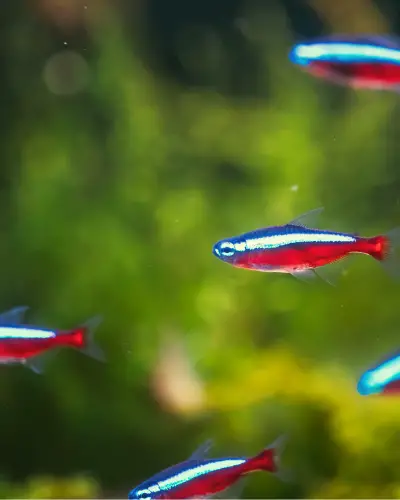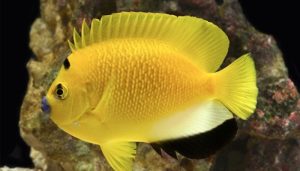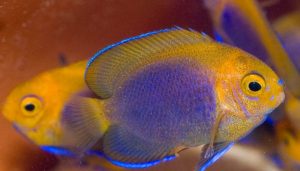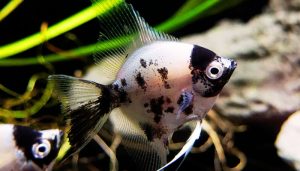Neon tetras are among the most popular aquarium fish, celebrated for their vibrant colors and peaceful nature. but are neon tetras hardy fish species?
Many aquarium enthusiasts often wonder if these fish are hardy and how best to care for them in a community tank. You can purchase neon tetras at nearby fish store or easily order them online for next-day delivery.
In this article, we will explore the secrets to successfully raising Neon Tetras in a tank and ensuring their health and happiness.
From water quality to feeding habits, key factors can significantly affect the well-being of these beautiful fish.

This ultimate care guide will explore the fundamental aspects of keeping neon tetras, including their health requirements, disease concerns, and tips for ensuring they thrive in your aquarium.
Table of Contents
ToggleAre Neon Tetras Hardy Fish Species?
Neon tetras (Paracheirodon innesi) are popular freshwater aquarium fish known for their vibrant colors and peaceful nature.
However, when it comes to hardiness, they are considered moderately delicate, especially when compared to some other beginner-friendly fish like guppies or zebra danios.
Factors Affecting Neon Tetra Hardiness:
- Water Quality: Neon tetras are sensitive to poor water conditions. They thrive in clean, well-maintained tanks with stable water parameters. Ammonia, nitrite, and nitrate spikes can stress or harm them.
- Water Parameters: They prefer soft, slightly acidic water (pH 6.0–7.0) and a temperature range of 70–81°F (21–27°C). Sudden changes in temperature or pH can be stressful.
- Disease Susceptibility: Neon tetras are prone to a condition called “neon tetra disease,” which is caused by a parasite (Pleistophora hyphessobryconis). This disease is incurable and can spread to other fish. They are also susceptible to ich (white spot disease) and fin rot if water quality is poor.
- Tank Mates: They are peaceful and do best with other small, non-aggressive fish. Aggressive or larger tank mates can stress or injure them.
- Acclimation: Neon tetras can be sensitive to abrupt changes when introduced to a new tank. Proper acclimation is essential to reduce stress.
Tips for Keeping Neon Tetras Healthy:
- Cycle the Tank: Ensure the aquarium is fully cycled before adding neon tetras.
- Maintain Water Quality: Perform regular water changes (20–30% weekly) and monitor water parameters.
- Schooling Fish: Keep them in groups of at least 6–10, as they are schooling fish and feel safer in numbers.
- Avoid Overcrowding: Provide enough space (at least 10 gallons for a small school) to reduce stress and aggression.
- Quarantine New Fish: Quarantine new additions to prevent the spread of diseases.
A Detailed Overview of Neon Tetra Fish
Neon tetras are small, freshwater fish native to the Amazon Basin, exhibiting a stunning blue body complemented by a vibrant red stripe. These peaceful schooling fish typically grow to about 1.5 inches in length, making them ideal for smaller fish tanks.
Their striking appearance and lively nature make them a popular choice for community tanks, often cohabiting well with other non-aggressive fish species like cardinal tetras.

In their natural habitat, neon tetras inhabit densely planted areas, indicating that live plants should be incorporated into their aquarium for optimal health.
The presence of plants not only mimics their wild environment but also provides hiding spots that enhance their comfort.
As social creatures, they flourish when kept in groups, allowing them to exhibit their natural behaviors and reduce stress levels. Properly understanding these aspects of neon tetra care is essential for maintaining a healthy aquarium.
Neon Tetra Health & Aquarium Requirements
To promote neon tetra health, it’s vital to establish ideal aquarium conditions. Water quality is paramount; thus, regular testing for pH, ammonia, nitrites, and nitrates is necessary.
Neon tetras prefer slightly acidic water with a pH between 6.0 and 7.0, and keep the water temperature between 70°F and 81°F. These fish thrive in well-maintained tanks, so ensuring proper filtration and regular water changes is crucial in preventing poor water conditions.
Feeding neon tetras a balanced diet is equally important for their health. Offer a variety of foods like flake, pellet, frozen foods, and live foods such as brine shrimp and baby brine shrimp.
It’s essential to monitor the amount of food given to avoid overfeeding, which can lead to water quality issues. By ensuring these aquarium requirements are met, aquarists can support the well-being of their neon tetras and foster a thriving aquatic environment.
What is Neon Tetra Disease (NTD)?
Neon Tetra Disease (NTD) is a common ailment affecting neon tetras and can be quite devastating if not addressed promptly. This disease is caused by a protozoan parasite, which leads to symptoms like a faded color, frayed fins, and abnormal swimming patterns.
Unfortunately, NTD is highly contagious among fish, making it essential for aquarists to monitor their fish closely for any signs of illness.
Prevention is the best approach when it comes to NTD. Maintaining excellent water quality and minimizing stress can help reduce the risk of outbreaks. Quarantining new fish before introducing them to the community tank is also recommended.
If NTD is suspected, affected fish should be isolated immediately to prevent further spread. Understanding the implications of this disease is critical for anyone looking to care for neon tetras effectively.
Essential Tips for Thriving Tetras
To ensure your neon tetras thrive, providing a stress-free environment is crucial. Start by selecting a suitable tank size; a minimum of 10 gallons is recommended for a small school of tetras.
Incorporating live plants and decorations can create a more natural habitat, offering hiding spots and reducing anxiety levels. Additionally, maintaining stable water parameters will help keep your tetras healthy and active.
Regular maintenance is key to a successful aquarium. Schedule consistent water changes to keep ammonia and nitrate levels low, and ensure your filtration system is functioning effectively.
Feeding a varied diet is also essential, offering foods like flakes, pellets, and occasional live or frozen options to keep them well-nourished. By implementing these essential tips, you can enjoy a bustling, vibrant neon tetra tank.
Selecting Compatible Neon Tetra Tank Mates
Choosing the right tank mates for your neon tetras is vital for maintaining harmony in your community tank. Given their peaceful nature, it’s best to select non-aggressive fish species that share similar water conditions.
Suitable companions include other schooling fish like cardinal tetras, guppies, and certain rasboras. Avoid larger or overly aggressive fish that may pose a threat to the smaller tetras.
When introducing new fish, ensure they are acclimated properly to avoid shocking the existing inhabitants. Gradually adjusting the water temperature and parameters of the new fish to match those of the established tank can help ease the transition.
Creating a harmonious community tank will not only enhance the well-being of your neon tetras but also contribute to a lively and visually appealing aquarium.
FAQs
Are neon tetras hardy fish?
Neon tetras are considered relatively hardy, but they do require specific care to thrive. They are sensitive to drastic changes in water conditions and require stable environments to stay healthy.
What size tank do I need to keep neon tetras?
A 20-gallon tank is recommended for keeping neon tetras, as they thrive best in groups and require ample swimming space to exhibit their natural behaviors.
Can I keep congo tetras with neon tetras?
Yes, congo tetras are peaceful fish and can be kept with neon tetras. However, be sure to monitor their interactions to ensure that both species are comfortable and not stressed.
What do I need to buy when setting up a tank for neon tetras?
When setting up a tank for neon tetras, you will need a good quality water conditioner, a filter to maintain water quality, plants for hiding, and a heater to keep the water at a stable temperature suitable for tropical fish.
How many neon tetras should I keep together?
Neon tetras tend to stay healthy when kept in groups. It is recommended to keep at least six neon tetras together to help them feel secure and exhibit natural social behavior.
What are the breeding neon requirements for neon tetras?
Breeding neon tetras requires specific conditions, including a separate breeding tank, soft and acidic water, and plenty of fine-leaved plants for the eggs to attach to. It is best to introduce a female neon tetras with a male for successful breeding.
How can I maintain water quality for neon tetras?
To maintain water quality for neon tetras, use a reliable filtration system, perform regular water changes, and monitor parameters like pH, ammonia, and nitrate levels. Keeping water conditions stable is essential for their health.
Why are my neon tetras not schooling together?
If your neon tetras are not schooling, it may be due to stress, poor water conditions, or not enough companions. Ensure you keep them in groups and that the water parameters are within their ideal range.
What should I do if I notice a sick neon tetra?
If you notice a sick neon tetra, first isolate the sick fish in a separate tank to prevent spreading any potential illness. Then, check the water quality and consider consulting an aquarium co-op or a veterinarian for treatment options.
Are black neon tetras a good option for beginners?
Yes, black neon tetras are generally good for beginners. They have similar care requirements to regular neon tetras and can adapt to a wide range of water parameters, making them a great choice for novice aquarists.
Conclusion
So, are neon tetras hardy? In conclusion, neon tetras are hardy and vibrant fish that can thrive in a well-maintained aquarium. By understanding the specific tetras needs—such as water quality, tank size, and compatible tank mates—aquarists can create an ideal environment for these beautiful schooling fish. With proper care and attention, neon tetras can bring life and color to any freshwater aquarium, making them an excellent addition for both beginners and experienced hobbyists alike.
Recommended posts
- Why Do Neon Tetras Keep Dying: (3 Weird Reasons Yours Do!)
- How Long Can Neon Tetras Go Without Food: (Shocking Truth!)
- How Big Do Neon Tetras Get: (Size Guide for Neon Fish Species)
- Neon Tetra Lifespan Expectancy: Avoid These 3 Deadly Mistakes!
- Neon Tetra Water Parameters 101: (A Comprehensive Guide)
- How Many Neon Tetras Should Be Kept Together: (Magic Number)
- Can Tetras Live with Angelfish: 7 EASY Compatibility Secrets




